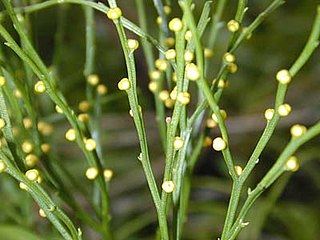
Lygodium is a genus of about 40 species of ferns, native to tropical regions across the world, with a few temperate species in eastern Asia and eastern North America. It is the sole genus in the family Lygodiaceae in the Pteridophyte Phylogeny Group classification of 2016. Alternatively, the genus may be placed as the only genus in the subfamily Lygodioideae of a more broadly defined family Schizaeaceae, the family placement used in Plants of the World Online as of November 2019.

Rosa multiflora is a species of rose known commonly as multiflora rose, baby rose, Japanese rose, many-flowered rose, seven-sisters rose, Eijitsu rose and rambler rose. It is native to eastern Asia, in China, Japan, and Korea. It should not be confused with Rosa rugosa, which is also known as "Japanese rose", or with polyantha roses which are garden cultivars derived from hybrids of R. multiflora. It was introduced to North America, where it is regarded as an invasive species.

Cibotium, also known as manfern, is a genus of 11 species of tropical tree ferns. It is the only genus in family Cibotiaceae in the Pteridophyte Phylogeny Group classification of 2016. Alternatively, the family may be treated as the subfamily Cibotioideae of a very broadly defined family Cyatheaceae, the family placement used for the genus in Plants of the World Online as of November 2019.

Elaeagnus, silverberry or oleaster, is a genus of about 50–70 species of flowering plants in the family Elaeagnaceae.

Nephrolepis exaltata, known as the sword fern or Boston fern, is a species of fern in the family Lomariopsidaceae. It is native to the Americas. This evergreen plant can reach as high as 40–90 centimetres (16–35 in), and in extreme cases up to 1.5 metres. It is also known as the Boston swordfern, wild Boston fern, Boston Blue Bell Fern, tuber ladder fern, or fishbone fern.

Luzula campestris, commonly known as field wood-rush, Good Friday grass or sweep's brush is a flowering plant in the rush family Juncaceae. It is a very common plant throughout temperate Europe extending to the Caucasus. This species of Luzula is found on all types of native grasslands, and cultivated areas such as lawns, golf-course greens and fields.
Sword fern is a common name for several ferns and may refer to:

Cenchrus is a widespread genus of plants in the grass family. Its species are native to many countries in Asia, Africa, Australia, the Americas, and various oceanic islands.

Nephrolepis is a genus of about 30 species of ferns. It is the only genus in the family Nephrolepidaceae, placed in the suborder Aspleniineae of the order Polypodiales in the Pteridophyte Phylogeny Group classification of 2016. The genus is commonly referred to as macho ferns or Boston ferns.

Perrottetia is a genus of flowering plants in the family Dipentodontaceae described as a family in 1824. Species occur in China, Southeast Asia, Papuasia, Hawaii, Australia, and Latin America. It is the largest genus of the recently described order Huerteales.

Amaranthus brownii was an annual herb in the family Amaranthaceae. The plant was found only on the small island of Nihoa in the Northwestern Hawaiian Islands, growing on rocky outcrops at altitudes of 120–215 m (394–705 ft). It was one of nine species of Amaranthus in the Hawaiian Islands, as well as the only endemic Hawaiian species of the genus. It is now considered extinct.

Osmundastrum is genus of leptosporangiate ferns in the family Osmundaceae with one living species, Osmundastrum cinnamomeum, the cinnamon fern. It is native to the Americas and eastern Asia, growing in swamps, bogs and moist woodlands.

Psilotum nudum, the whisk fern, is a fernlike plant. Like the other species in the order Psilotales, it lacks roots.

Luzula multiflora, the common woodrush or heath wood-rush, is a species of flowering plant in the rush family.

Angiopteris evecta, commonly known as the king fern, giant fern, elephant fern, oriental vessel fern, Madagascar tree fern, or mule's Foot fern, is a very large rainforest fern in the family Marattiaceae native to most parts of Southeast Asia and Oceania. It has a history dating back about 300 million years, and is believed to have the longest fronds of any fern in the world.

Asplenium adiantum-nigrum is a common species of fern known by the common name black spleenwort. It is found mostly in Africa, Europe, and Eurasia, but is also native to a few locales in Mexico and the United States.

Nephrolepis cordifolia, is a fern native to the global tropics, including northeastern Australia and Asia. It has many common names including fishbone fern, tuberous sword fern, tuber ladder fern, erect sword fern, narrow sword fern and ladder fern, and herringbone fern. It is similar to the related fern Nephrolepis exaltata.

Nephrolepis biserrata is a tropical fern, endemic to Florida, Mexico, the West Indies, Central America, South America, Africa, and southeast Asia.

Dipteronia brownii is an extinct species in the soapberry family (Sapindaceae) described in 2001. Fossils of D. brownii are known from stratigraphic formations in North America and Asia ranging in age between Paleocene to Early Oligocene.
Ophioglossum petiolatum is a species of fern in the family Ophioglossaceae. William Jackson Hooker named this species in 1823.


















